Podcast: Play in new window | Download
Subscribe: Apple Podcasts | RSS
The Yaqui or Yoeme people have lived in the river valleys of south-central Sonora in northwestern Mexico since time immemorial. The name “Yaqui” comes from the Yoeme word “Hiyakim” which was the name these people gave to their homeland. The Yaqui resisted outside influence for hundreds of years and as a result much of their culture has survived into the 21st Century. Yaqui culture is full of many legends. Here are 5.
Number One: How the Badger Named the Sun
In the early days of the Surem people, the smaller people who used to inhabit the Yaqui lands, no one knew the name of the sun. They longed to give it a proper name, so they gathered for a great council along the banks of the Surem River. Many offered their thoughts, yet no suitable name was found. Day after day, they debated, uncertain whether the sun was male or female, making it difficult to decide on an appropriate name. Unable to reach an agreement, they extended an invitation to all the animals of the world to join the discussion.
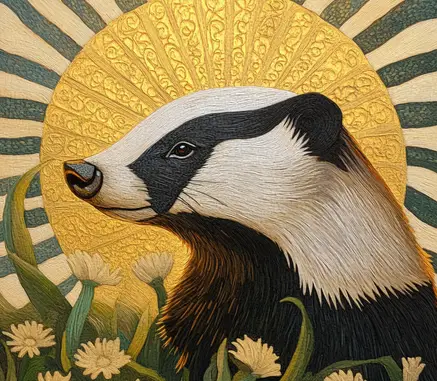 As the animals and people assembled before dawn by the river’s edge, the sun slowly began to rise. At that moment, a badger emerged from its burrow and boldly spoke: “The sun is a man, for he rises from the earth just as I do.” With that declaration, the badger darted away.
As the animals and people assembled before dawn by the river’s edge, the sun slowly began to rise. At that moment, a badger emerged from its burrow and boldly spoke: “The sun is a man, for he rises from the earth just as I do.” With that declaration, the badger darted away.
The others, recognizing his wisdom, chased after him to celebrate his insight. They wished to honor him with a grand feast and plentiful offerings. However, the badger, misunderstanding their intent, believed they meant to punish him. Frightened, he fled into his burrow and refused to come out. Since that day, badgers have remained wary, rarely venturing far from their underground homes.
Some tell a different version of this tale, saying that it was the tortilla fish who first knew the sun’s name, while others claim it was the rooster. Among the Huichol people, a similar story exists, except in their telling, it is the turkey who names the sun.
Number Two: The Two Bears
In the land of the Yaquis, two inseparable friends, Anoki’ichi and Bali’ichi, were known for their mischief. One day, they killed a bear and carefully preserved its hide. Amused by their find, they stuffed the skin with grass to make it appear lifelike. After a few days, the hide had stiffened, holding its shape. This gave Anoki’ichi an idea—Bali’ichi would wear the bear skin, and together they would travel from village to village, entertaining people for money.
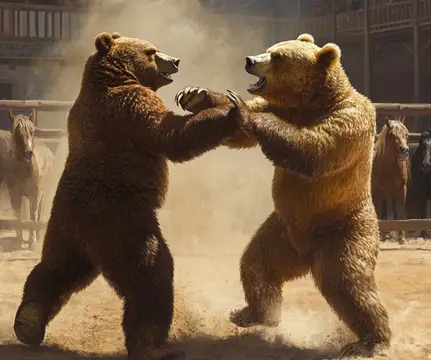 With a rope tied around his “bear,” Anoki’ichi played music while Bali’ichi danced, delighting crowds and earning a living. Their performances brought them to a wealthy landowner’s estate, where they impressed him so much that he insisted on buying the bear. Despite initial refusals, Anoki’ichi ultimately gave in when he was offered a fortune in gold and a bride. Without hesitation, he took the riches and left, abandoning his friend.
With a rope tied around his “bear,” Anoki’ichi played music while Bali’ichi danced, delighting crowds and earning a living. Their performances brought them to a wealthy landowner’s estate, where they impressed him so much that he insisted on buying the bear. Despite initial refusals, Anoki’ichi ultimately gave in when he was offered a fortune in gold and a bride. Without hesitation, he took the riches and left, abandoning his friend.
Bali’ichi was placed in a corral with another bear. To his shock, the other creature was also a man disguised in a bear skin. Realizing their shared predicament, they devised a plan: each day, they staged fierce battles to convince their master they were real animals. They lived this way for months, until one afternoon, while their master slept, they decided to remove their masks for a brief rest.
Unluckily, the landowner awoke to see the two “bears” smoking and chatting like men. Enraged by the deception, he grabbed his bow and arrows, intending to kill them. But before he could act, the two friends bolted, leaping over the fence and vanishing into the wilderness. From that day on, no one ever saw them again.
Number Three: Little Yellow Bird
There was once a beautiful young woman named Sawali Wi-ikit, or Little Yellow Bird, known for her long, lovely black hair and shining eyes. However, she was disobedient, often wandering through the night without her parents’ permission, meeting up with strange men and doing who knows what. She would return only at dawn to sleep.
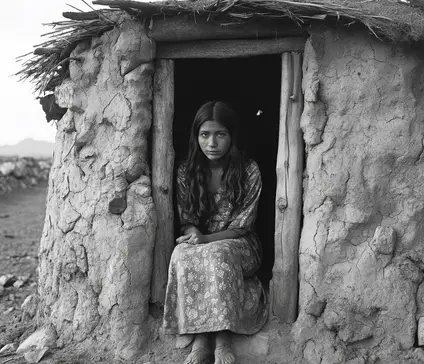 One morning, her mother warned her to stop her reckless ways and help with household duties, but Little Yellow Bird ignored the advice. That night, she went to a friend’s house, where she drank pitahaya wine until she was intoxicated. This was not the first time. At dawn, she stumbled home, where her father confronted her. He told her that if she refused to change, she should leave. He threatened to beat her with branches from a palo verde tree that he had cut specifically to dole out her punishment. Fearing a beating, Little Yellow Bird agreed to leave and spare the family any further shame.
One morning, her mother warned her to stop her reckless ways and help with household duties, but Little Yellow Bird ignored the advice. That night, she went to a friend’s house, where she drank pitahaya wine until she was intoxicated. This was not the first time. At dawn, she stumbled home, where her father confronted her. He told her that if she refused to change, she should leave. He threatened to beat her with branches from a palo verde tree that he had cut specifically to dole out her punishment. Fearing a beating, Little Yellow Bird agreed to leave and spare the family any further shame.
Her father, along with a local shaman, led her outside the village to a mesquite tree. The shaman instructed her to seek forgiveness from the spirits, offering her a chance to return home if she repented. But Little Yellow Bird refused. Instead, she asked to be turned into a tree, a stone, or an animal—anything but a good woman.
At that moment, she was transformed into a stone.
The shaman returned to the village and told everyone what had happened. Fearful of meeting the same fate, the young people of the village of Rahum became more respectful toward their parents. Meanwhile, the stone that had once been Little Yellow Bird began to move on its own, appearing in different places—from Rahum to Potam, to Torim. People would place it in one spot, only to find it had moved by morning.
The stone was last seen near Vicam, but where Little Yellow Bird is now, no one knows.
Number Four: The Five Friends of Takochai
In the land of the Yaqui, there was an industrious man named Teta Hiapsi, known for his skill in building and creating things of value. He gathered a group of workers, offering to pay them in large silver and gold discs called te’okita and sawai tomi, the traditional currency of the Yaquis. With their help, he constructed a massive enclosure spanning twenty-four kilometers, surrounding a lush forest filled with wild animals and water sources. His wealth was immense, and he stored great treasures of silver and gold in a deep cave, using it to pay his workers every Saturday.
One Saturday, however, he decided not to pay a clever Yaqui trickster named Takochai, instead telling him, “You may do whatever you wish to me to get even.” Amused by the challenge, Takochai set out to gather a group of extraordinary individuals to aid him.
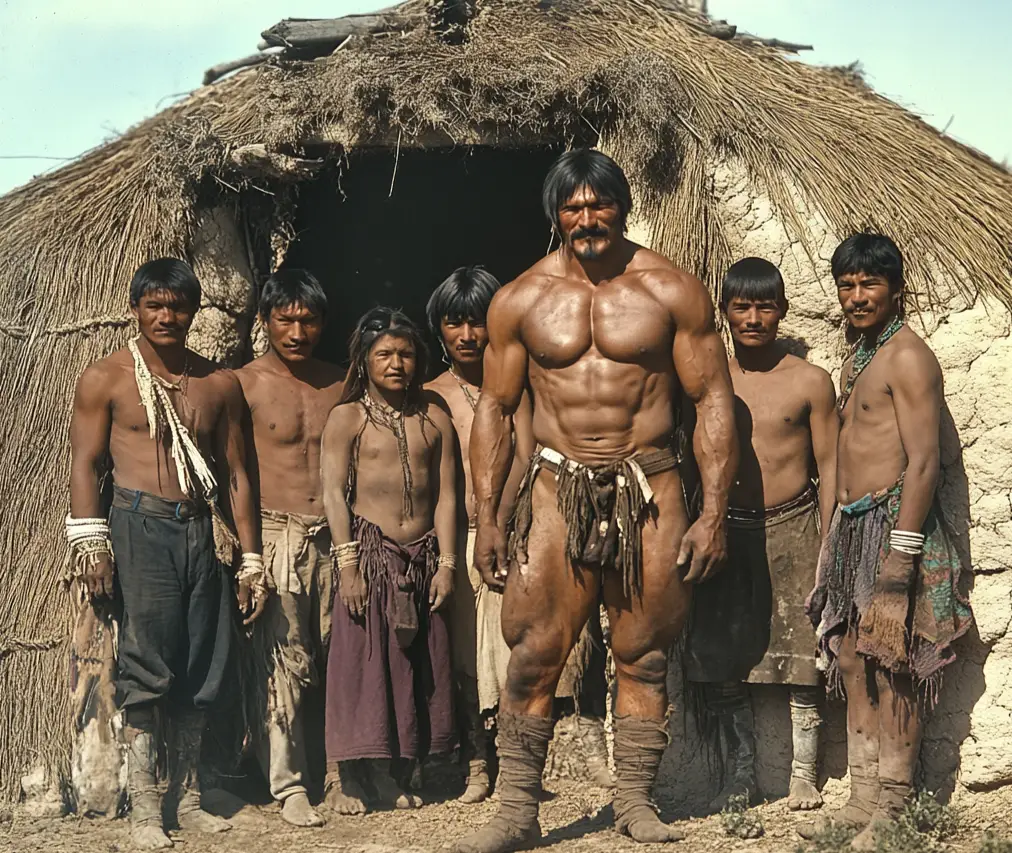 His journey first led him to a giant of a man named Hoso Hoseli, so strong that he uprooted mesquite trees and sahuaros as effortlessly as if they were blades of grass. Takochai invited him to join, and together they continued on.
His journey first led him to a giant of a man named Hoso Hoseli, so strong that he uprooted mesquite trees and sahuaros as effortlessly as if they were blades of grass. Takochai invited him to join, and together they continued on.
Next, they encountered Mekkata’obia, a hunter whose eyesight and accuracy were so great that he could shoot a deer in mountains barely visible in the distance. He, too, joined them.
Further along, they met Yuku Beo’oti, a man so fast that he had to tie one leg to slow himself down. With both legs free, he could run faster than the wind. He eagerly agreed to join the growing group.
Then they came across a peculiar little man named Tasa’a Bali, who wore a skin cap decorated with red and green feathers. By adjusting his cap, he could summon heat or cold at will, making the weather shift instantly. He, too, joined them.
Lastly, they met Hekkateni’a, a man with lungs so powerful that he could generate massive gusts of wind with a single breath, and could blow down trees from miles away. With his agreement, the band of six was complete, and they set out to confront Teta Hiapsi.
Upon arriving at the gigantic property enclosure, Takochai boldly challenged Teta Hiapsi to a contest, wagering his life against the wealthy man’s vast fortune. Teta Hiapsi, intrigued, proposed a race—his daughter, Sochik, a witch who could fly, would compete against Yuku Beo’oti. The race would span an incredible distance, one that even a man on a fast horse could not complete in a single summer day.
At the start, Sochik took off into the sky while Yuku Beo’oti sped across the land. Reaching the halfway point, he rested briefly, using a tree stump as a pillow. Seeing this, Sochik, using trickery, emptied his water canteen and continued ahead. But Mekkata’obia, from a great distance, saw what had happened and shot an arrow into the tree near Yuku Beo’oti’s head, waking him. Realizing his water was gone, Yuku Beo’oti dashed forward, overtook the witch Sochik, refilled his canteen, and won the race.
Having lost the challenge, Teta Hiapsi granted Takochai half of his wealth, but proposed another test: Takochai and his men would have to survive a night inside a massive, windowless oven, traditionally used for cooking large animals. If they survived, they would win everything.
Takochai agreed, and his group entered the oven. Teta Hiapsi and his men sealed it, surrounding it with wood and lighting an intense fire. However, inside the oven, Tasa’a Bali simply adjusted his cap, turning the green feathers to the right, and cooled the air inside. By morning, when Teta Hiapsi opened the oven, the six men stepped out, shivering from the cold.
Having lost again, Teta Hiapsi handed over the rest of his wealth, and Hoso Hoseli effortlessly shouldered the massive load of gold and silver. As the victorious group left, Teta Hiapsi, furious, gathered six hundred warriors to pursue them.
But Mekkata’obia, with his keen vision, spotted the approaching warriors from afar. Takochai quickly ordered Hekkateni’a to act. Covering one nostril, Hekkateni’a unleashed a mighty gust, lifting the warriors high into the air before letting them plummet back to the ground like stones.
With their enemies defeated and their fortune secured, Takochai and his five extraordinary friends marched away in triumph.
Number Five: The Ku Bird
Among the Yaqui people, there was once a bird born into the world with nothing, not even a single feather to cover his body. Naked and exposed, he suffered greatly, especially in the cold of winter. The other birds soared through the skies in their brilliant plumage, while he shivered, longing for the warmth of even the smallest feather.
Years passed, and the little bird endured in quiet misery until one day, he approached the wise and solemn Owl. With a humble heart, he pleaded, “Brother Owl, please help me. If you lend me even a few feathers—just enough to shield me from the cold—I will be forever grateful and will repay you as soon as I am able.”
Owl, known among the birds for his wisdom and fairness, listened carefully. He ruffled his own feathers and gazed at the shivering creature before him. Then, with a nod, he replied, “Worry no more. I will summon all the birds—great and small—and ask each one to give you a single feather. That way, you will have enough to cover your entire body.”
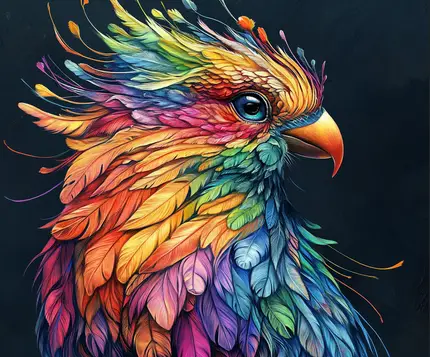 Gratitude filled Ku Bird’s heart. “You are kind, Brother Owl,” he said. “When I have many feathers, I will return one to each bird who has helped me.”
Gratitude filled Ku Bird’s heart. “You are kind, Brother Owl,” he said. “When I have many feathers, I will return one to each bird who has helped me.”
Owl agreed. “At sunrise tomorrow, all the birds shall gather to discuss this.” Then, without another word, he spread his wings and disappeared into the night to summon the council.
By dawn, the sky was alive with the flurry of wings as birds of every kind assembled. At Owl’s request, Ku Bird stepped forward, but he hesitated, ashamed of his bare skin. The other birds gasped when they saw him, their hearts filled with sympathy.
One by one, they each plucked a single feather from their own wings and tails, offering it to Ku Bird. The hawk gave a sleek brown feather, the parrot a brilliant green one, the cardinal a deep red. Even the smallest sparrow contributed a delicate plume. Soon, Ku Bird was no longer bare, he was adorned in a dazzling coat of a thousand colors.
Ku Bird bowed deeply. “To Brother Owl, I entrust the task of returning these feathers in a year’s time,” he declared. “I will repay each of you for your kindness.”
Days later, Ku Bird came upon a spring of crystal-clear water where many birds gathered. As he approached, they turned to look at him—and they gasped. Before them stood a creature unlike any they had ever seen. His feathers shimmered with every hue imaginable, reflecting the sunlight like a living rainbow.
“Who is this magnificent bird?” they whispered in awe.
Some believed he was a prince. Others called him the bird of a thousand colors. None recognized him as the same pitiful creature they had once felt sorry for.
But Ku Bird had no intention of returning the borrowed feathers. He disappeared into the world, vanishing like a phantom on the wind. Days turned into weeks, weeks into months, and when the year had passed, the birds realized he was gone. They searched for him far and wide, but he was never seen again.
Even to this day, Owl has not stopped searching. Each night, his mournful call echoes through the trees:
“Ku, Ku, Ku, Ku…”
He cannot say Ku Bird’s full name, only this sorrowful chant.
Many generations have come and gone, but the Yaquis say Ku Bird still exists, hidden away in a secret enchanted waterhole near the sea known only to the elders, west of the old village of Potam. Some claim they have heard his distant song.
Yet one truth remains: Ku never repaid his debt.
REFERENCES
Warner Giddings, Ruth. Yaqui Myths and Legends. Tucson: University of Arizona Press, 1974.
We are Amazon affiliates. Purchase the book on Amazon here: https://amzn.to/4i97ufr
